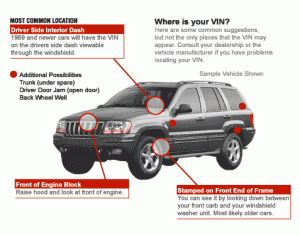 Although we’re all fairly good at keeping a record of the important numbers in our lives, few people think to write down their Vehicle Identification Number. After all, isn’t it on all the insurance papers? Yes, it is, but the VIN contains more information than most consumers realize and is just as “vital” as any other number you may keep in a “safe place.”
Although we’re all fairly good at keeping a record of the important numbers in our lives, few people think to write down their Vehicle Identification Number. After all, isn’t it on all the insurance papers? Yes, it is, but the VIN contains more information than most consumers realize and is just as “vital” as any other number you may keep in a “safe place.”
Normally, the VIN is located on the dash near the windshield on the driver’s side. Other common locations include:
– The inner wheel arch on the left side.
– The driver’s door.
– The steering column.
– The radiator’s support bracket.
All VINs have 17 characters that form a manufacturer’s serial number giving precise information about the car or truck in question. The four major parts of the code include:
– Three characters for the World Manufacturer’s Identification (WMI).
– Five characters for the Vehicle Description Section (VDS).
– One digit for the VIN Accuracy Check.
– Eight characters for the Vehicle Identification Section (VIS).
The first character of the WMI sequence tells where the car was made. For the United States, the number will be a 1 or a 4. The second character is the manufacturer, but you can’t make assumptions about the ID without knowing the code. “C,” for instance, means Chrysler, but “6” means Cadillac. The third character gives the manufacturing division or vehicle type.
The codes employed in the VDS series are so complex, they can be used to decipher engine type and body style and even what kind of brakes the vehicle employs. The VIS sequence gives both model year and assembly plant as well as assigning a unique serial number to the specific unit in question.
In a nutshell, the VIN is a precise capsule of information about your car or truck. If you are away from home — and away from all your insurance papers — have the VIN stored on your phone or tucked in your wallet can be a huge help in the event of an accident or theft situation.





